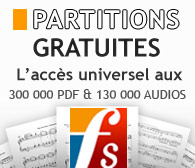| Traditional - "The King of the Faeries" for Flute & Harp Flute et Harpe |
VoirPDF : "The King of the Faeries" for Flûte & Harp (6 pages - 259.28 Ko)4 526x⬇ VoirPDF : All Parts (249.34 Ko) VoirPDF : Flûte (92.3 Ko) VoirPDF : Harpe (87.23 Ko) MP3 : "The King of the Faeries" for Flute & Harp 1340x⬇ 14378x
| Compositeur : | Traditional | ||
| Instrumentation : | Flute et Harpe | ||
| Genre : | Celtique | ||
| Arrangeur : Editeur : | MAGATAGAN, MICHAEL (1960 - ) | ||
| Droit d'auteur : | Public Domain | ||
| Ajoutée par magataganm, 11 Oct 2012 A fairy (also faery, faerie, fay, fae; euphemistically wee folk, good folk, people of peace, fair folk, etc.) is a type of mythical being or legendary creature, a form of spirit, often described as metaphysical, supernatural or preternatural. The Irish banshee (Irish Gaelic "bean sí" or Scottish Gaelic "bean shìth", which both mean "fairy woman") is sometimes described as a ghost Historians believe that the fairy queens and kings are in fact the old pagan gods and goddesses 'in disguise' who have long been revered by the Irish. Once stated that, "the Celtic gods of Ireland had long been wiped out, buried under the sway of Catholicism". Many who have been to the Emerald Isle, or listened to many folk tales can see that the old gods live on in folk tales as the giants of the hill; the Gobhan Saor who built all the bridges of Ireland; the Gille Decair, a clown and trickster; the carl (serf) of the drab coat and many others. The old deities were once worshipped throughout Ireland, however it is in the west that they are best remembered now, the east having been more Christianized and anglicised, and subject to more invasions. By contrast, the west of Ireland, to which the native Irish were driven ("to hell or Connaught") has held on longer to her ancient heritage. Fairies resemble various beings of other mythologies, though even folklore that uses the term fairy offers many definitions. Sometimes the term describes any magical creature, including goblins or gnomes: at other times, the term only describes a specific type of more ethereal creature. | |||
© 2000 - 2024
Accueil - Nouveautés - Compositeurs
Mentions légales - Version intégrale








